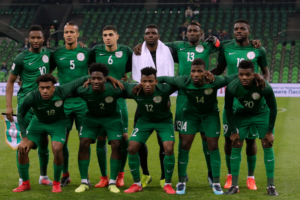Welcome to this post about The Glittering Ride of Soccer: Nigeria’s Colorful Influence, via Afrokonnect.
Ah, soccer (or football, for the purists out there) – the game where 22 players chase a ball for 90 minutes, and at the end, Germany usually wins (except when they don’t).
But let’s shimmy over to a corner of this sporting world that’s as vibrant as a Lagos market on a Saturday morning: Nigeria’s dazzling influence on the beautiful game.
Ready for a jaunt down this footballing memory lane? Let’s go!
The Green Eagles Take Flight
Before Nigeria’s Super Eagles soared, soccer in Nigeria was like a fun family barbecue – everyone’s invited, but not everyone knows how to dance.
British colonialists introduced the sport in the late 19th century, probably not expecting that Nigerians would take it, add some afrobeat to it, and make it their own.
In those early days, it was more about fun and less about technique – imagine a Sunday league game, but with more flair and less complaining about the ref.
Nowadays, it’s still fun to watch these, place a bet here and there with a reliable mobile app like 1xBet, review available at the link https://www.telecomasia.net/zm/sports-betting/reviews/1xbet/mobile-app/,
But the colorful richness of the early days sometimes beats the experience and tactical extravagance of the current teams.
The Early Years: Leather Balls and Bare Feet
In the early 20th century, Nigerian soccer was like that kid in school who’s good at everything but still figuring things out.
Players often played barefoot, turning agility into an art form. It wasn’t just a game; it was a carnival.
The ball might have been made from stitched leather, but the skills were pure gold.
The 70s and 80s: Cranking Up the Volume
Leap ahead to the 1970s and 1980s, and Nigerian soccer had transformed into the trendsetter of the sports world.
The Green Eagles, as they were known during that era, transcended mere play; their game was akin to a captivating performance.
In the 1980 Africa Cup of Nations, hosted and won by Nigeria, was like their breakout album.
The country pulsated to the rhythm of victory, and it wasn’t just the goals; it was the style, the flair, the sheer joy of play.
Nigerian soccer was a spicy stew, and everyone wanted a taste.
The 90s: Nigeria Shakes the World
1990s were to Nigerian soccer what the moonwalk was to Michael Jackson – iconic.
The 1994 World Cup debut was like a blockbuster movie premiere.
When the Super Eagles strutted onto the world stage with the swagger of Nollywood stars.
They didn’t just play; they entertained, with players like Jay-Jay Okocha turning the midfield into a dance floor.
And who can forget the 1996 Olympics?
Nigeria’s U23 team didn’t just win gold; they redefined what African teams could achieve on the global stage.
The 2000s and Beyond: A Rollercoaster Ride
Post-2000, Nigerian soccer has been like a Nollywood drama – full of twists and turns.
There have been highs, like the 2013 Africa Cup of Nations win, and lows, like the occasional World Cup heartbreak.
But through it all, the passion and flair remain.
The Super Eagles continue to be a team that can surprise anyone on their day – like that uncle who unexpectedly breaks into dance at the family reunion and suddenly becomes the life of the party.
Conclusion: The Unstoppable Beat of Nigerian Soccer

From its humble beginnings to its current status as an African powerhouse, Nigerian soccer has been a journey as colorful and dynamic as the country itself.
Soccer in Nigeria is a symphony of footwork, heart, and rhythm.
The Super Eagles have not just played the game; they’ve enchanted the world with their prowess.
From their stunning performances at the Olympics to their spirited endeavors in qualifiers, they’ve etched a lasting legacy in the annals of the sport.
And let’s not forget the fans, the heartbeat of Nigerian soccer.
They turn stadiums into a carnival of colors, with their green and white attires, elaborate face paints, and infectious chants.
Nigerian fans are not mere spectators; they are an integral part of the game, a 12th player, if you will.
Their passion is the fuel that drives the team, their songs the soundtrack of Nigerian soccer.
From the bustling avenues of Lagos to the vast expanses of the Sahara, each soccer moment – every kick, every goal, every pulse-racing play – resonates deeply with the passionate fans.
These ardent supporters are more than just onlookers; they are the true champions of the sport’s essence.
Nigerian soccer transcends the boundaries of a mere game. It emerges as a potent cultural symbol, a beacon of national pride, embodying the relentless spirit of its people.
On the field, it’s not just a match; it’s a harmonious ballet of skill and fervor, unfolding on verdant fields under the broad expanse of the African sky.
In the end, Nigerian soccer is much like a well-played afrobeat song – it’s got rhythm, soul, and an infectious energy that you can’t help but move to.
It’s a beautiful chaos, a delightful dance of feet and football, and it’s absolutely, unapologetically Nigerian.
And just like the best parties, everyone’s invited to this football fiesta. Just remember to bring your dancing shoes!















